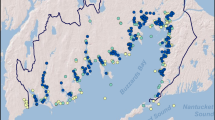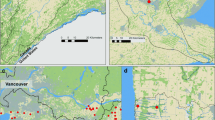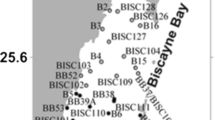Abstract
Microcystin (MCY)-producing harmful cyanobacterial blooms (cHABs) are an annual occurrence in Lake Erie, and buoys equipped with water quality sondes have been deployed to help researchers and resource managers track cHABs. The objective of this study was to determine how well water quality sondes attached to buoys measure total algae and cyanobacterial biomass and water turbidity. Water samples were collected next to two data buoys in western Lake Erie (near Gibraltar Island and in the Sandusky subbasin) throughout summers 2015, 2016, and 2017 to determine correlations between buoy sonde data and water sample data. MCY and nutrient concentrations were also measured. Significant (P < 0.001) linear relationships (R2 > 0.75) occurred between cyanobacteria buoy and water sample data at the Gibraltar buoy, but not at the Sandusky buoy; however, the coefficients at the Gibraltar buoy differed significantly across years. There was a significant correlation between buoy and water sample total chlorophyll data at both buoys, but the coefficient varied considerably between buoys and among years. Total MCY concentrations at the Gibraltar buoy followed similar temporal patterns as buoy and water sample cyanobacterial biomass data, and the ratio of MCY to cyanobacteria-chlorophyll decreased with decreased ambient nitrate concentrations. These results suggest that buoy data are difficult to compare across time and space. Additionally, the inclusion of nitrate concentration data can lead to more robust predictions on the relative toxicity of blooms. Overall, deployed buoys with sondes that are routinely cleaned and calibrated can track relative cyanobacteria abundance and be used as an early warning system for potentially toxic blooms.








Similar content being viewed by others
References
Backer LC, Landsberg JH, Miller M, Keel K, Taylor T (2013) Canine cyanotoxin poisonings in the United States (1920s-2012): review of suspected and confirmed cases from three data sources. Toxins 5:1597–1628. https://doi.org/10.3390/toxins5091597
Bastien C, Cardin R, Veilleux É, Deblois C, Warren A, Laurion I (2011) Performance evaluation of phycocyanin probes for the monitoring of cyanobacteria. J Environ Monit 13:110–118. https://doi.org/10.1039/C0EM00366B
Beardall J, Young E, Roberts S (2001) Approaches for determining phytoplankton nutrient limitation. Aquat Sci 63:44–69
Beutler M, Wiltshire KH, Meyer B, Moldaenke C, Lüring C, Meyerhöfer M, Hansen UP, Dau H (2002) A fluorometric method for the differentiation of algal populations in vivo and in situ. Photosynth Res 72:39–53
Bingham M, Sinha S, Lupi F (2015) Economic benefits of reducing harmful algal blooms in Lake Erie. Environmental Consulting & Technology, Inc., Environmental Consulting & Technology, Inc.
Bowling LC, Zamyadi A, Henderson RK (2016) Assessment of in situ fluorometry to measure cyanobacterial presence in water bodies with diverse cyanobacterial populations. Water Res 105:22–33. https://doi.org/10.1016/j.watres.2016.08.051
Bridgeman TB, Chaffin JD, Kane DD, Conroy JD, Panek SE, Armenio PM (2012) From river to lake: phosphorus partitioning and algal community compositional changes in Western Lake Erie. J Great Lakes Res 38:90–97
Bullerjahn GS, McKay RM, Davis TW et al (2016) Global solutions to regional problems: collecting global expertise to address the problem of harmful cyanobacterial blooms. A Lake Erie case study. Harmful Algae 54:223–238. https://doi.org/10.1016/j.hal.2016.01.003
Campbell D, Hurry V, Clarke AK, Gustafsson P, Oquist G (1998) Chlorophyll fluorescence analysis of cyanobacterial photosynthesis and acclimation. Microbiol Mol Biol Rev 62:667–683
Chaffin JD, Bridgeman TB, Heckathorn SA, Mishra S (2011) Assessment of Microcystis growth rate potential and nutrient status across a trophic gradient in western Lake Erie. J Great Lakes Res 37:92–100. https://doi.org/10.1016/j.jglr.2010.11.016
Chaffin JD, Bridgeman TB, Heckathorn SA, Krause AE (2012) Role of suspended sediments and mixing in reducing photoinhibition in the bloom-forming cyanobacterium Microcystis. J Water Res Prot 4:1029–1041
Chaffin JD, Bridgeman TB, Bade DL (2013) Nitrogen constrains the growth of late summer cyanobacterial blooms in Lake Erie. Adv Microbiol 03:16–26. https://doi.org/10.4236/aim.2013.36A003
Chaffin JD, Sigler V, Bridgeman TB (2014) Connecting the blooms: tracking and establishing the origin of the record-breaking Lake Erie Microcystis bloom of 2011 using DGGE. Aquat Microb Ecol 73:29–39
Chaffin JD, Davis TW, Smith DJ, Baer MM, Dick GJ (2018) Interactions between nitrogen form, loading rate, and light intensity on Microcystis and Planktothrix growth and microcystin production. Harmful Algae 73:84–97. https://doi.org/10.1016/j.hal.2018.02.001
Chang D-W, Hobson P, Burch M, Lin T-F (2012) Measurement of cyanobacteria using in-vivo fluoroscopy—effect of cyanobacterial species, pigments, and colonies. Water Res 46:5037–5048. https://doi.org/10.1016/j.watres.2012.06.050
Conroy JD, Kane DD, Dolan DM, Edwards WJ, Charlton MN, Culver DA (2005) Temporal trends in Lake Erie plankton biomass: roles of external phosphorus loading and Dreissenid mussels. J Great Lakes Res 31(Supplement 2):89–110. https://doi.org/10.1016/S0380-1330(05)70307-5
Conroy JD, Kane DD, Quinlan EL, Edwards WJ, Culver DA (2017) Abiotic and biotic controls of phytoplankton biomass dynamics in a freshwater tributary, estuary, and large lake ecosystem: Sandusky Bay (Lake Erie) chemostat. Inland Waters 1–20. https://doi.org/10.1080/20442041.2017.1395142
Davis CC (1964) Evidence for the eutrophication of Lake Erie from phytoplankton records. Limnol Oceanogr 9:275–283
Davis TW, Koch F, Marcoval MA, Wilhelm SW, Gobler CJ (2012) Mesozooplankton and microzooplankton grazing during cyanobacterial blooms in the western basin of Lake Erie. Harmful Algae 15:26–35. https://doi.org/10.1016/j.hal.2011.11.002
DePinto JV, Young TC, McIlroy LM (1986) Great Lakes water quality improvement. Environ Sci Technol 20:752–759
Dodds WK, Bouska WW, Eitzmann JL, Pilger TJ, Pitts KL, Riley AJ, Schloesser JT, Thornbrugh DJ (2009) Eutrophication of U.S. freshwaters: analysis of potential economic damages. Environ Sci Technol 43:12–19. https://doi.org/10.1021/es801217q
Dyble J, Fahnenstiel GL, Litaker RW, Millie DF, Tester PA (2008) Microcystin concentrations and genetic diversity of Microcystis in the lower Great Lakes. Environ Toxicol 23:507–516
Fischer WJ, Garthwaite I, Miles CO, Ross KM, Aggen JB, Chamberlin AR, Towers NR, Dietrich DR (2001) Congener-independent immunoassay for microcystins and nodularins. Environ Sci Technol 35:4849–4856. https://doi.org/10.1021/es011182f
Ghadouani A, Smith REH (2005) Phytoplankton distribution in Lake Erie as assessed by a new in situ spectrofluorometric technique. J Great Lakes Res 31:154–167
Gobler CJ, Burkholder JM, Davis TW et al (2016) The dual role of nitrogen supply in controlling the growth and toxicity of cyanobacterial blooms. Harmful Algae 54:87–97. https://doi.org/10.1016/j.hal.2016.01.010
Golnick PC, Chaffin JD, Bridgeman TB, Zellner BC, Simons VE (2016) A comparison of water sampling and analytical methods in western Lake Erie. J Great Lakes Res 42:965–971. https://doi.org/10.1016/j.jglr.2016.07.031
Gregor J, Marsálek B (2004) Freshwater phytoplankton quantification by chlorophyll a: a comparative study of in vitro, in vivo and in situ methods. Water Res 38:517–522. https://doi.org/10.1016/j.watres.2003.10.033
Hampel JJ, McCarthy MJ, Gardner WS et al (2018) Nitrification and ammonium dynamics in Taihu Lake, China: seasonal competition for ammonium between nitrifiers and cyanobacteria. Biogeosciences 15:733–748. https://doi.org/10.5194/bg-15-733-2018
Harke MJ, Gobler CJ (2015) Daily transcriptome changes reveal the role of nitrogen in controlling microcystin synthesis and nutrient transport in the toxic cyanobacterium, Microcystis aeruginosa. BMC Genomics 16:1068
Harke MJ, Davis TW, Watson SB, Gobler CJ (2016a) Nutrient-controlled niche differentiation of western Lake Erie cyanobacterial populations revealed via metatranscriptomic surveys. Environ Sci Technol 50:604–615. https://doi.org/10.1021/acs.est.5b03931
Harke MJ, Steffen MM, Gobler CJ, Otten TG, Wilhelm SW, Wood SA, Paerl HW (2016b) A review of the global ecology, genomics, and biogeography of the toxic cyanobacterium, Microcystis spp. Harmful Algae 54:4–20. https://doi.org/10.1016/j.hal.2015.12.007
Harrison JW, Howell ET, Watson SB, Smith REH (2016) Improved estimates of phytoplankton community composition based on in situ spectral fluorescence: use of ordination and field-derived norm spectra for the bbe FluoroProbe. Can J Fish Aquat Sci 73:1472–1482. https://doi.org/10.1139/cjfas-2015-0360
Hodges CM, Wood SA, Puddick J, McBride CG, Hamilton DP (2017) Sensor manufacturer, temperature, and cyanobacteria morphology affect phycocyanin fluorescence measurements. Environ Sci Pollut Res 25:1–10. https://doi.org/10.1007/s11356-017-0473-5
Horst GP, Sarnelle O, White JD, Hamilton SK, Kaul RRB, Bressie JD (2014) Nitrogen availability increases the toxin quota of a harmful cyanobacterium, Microcystis aeruginosa. Water Res 54:188–198
Houliez E, Lizon F, Thyssen M, Artigas LF, Schmitt FG (2012) Spectral fluorometric characterization of haptophyte dynamics using the FluoroProbe: an application in the eastern English Channel for monitoring Phaeocystis globosa. J Plankton Res 34:136–151. https://doi.org/10.1093/plankt/fbr091
Huisman J, Matthijs HCP, Visser PM (eds) (2010) Harmful cyanobacteria, Softcover reprint of hardcover 1st ed. 2005 edition. Springer, Place of publication not identified
Humbert J-F, Törökné A (2016) New tools for the monitoring of cyanobacteria in freshwater ecosystems. In Meriluoto J, Spoof L, Codd GA (eds) Handbook of cyanobacterial monitoring and cyanotoxin analysis. Wiley, pp 84–88
Jochens AE, Malone TC, Stumpf RP, Hickey BM, Carter M, Morrison R, Dyble J, Jones B, Trainer VL (2010) Integrated ocean observing system in support of forecasting harmful algal blooms. Mar Technol Soc J 44:99–121. https://doi.org/10.4031/MTSJ.44.6.16
Kane DD, Conroy JD, Richards RP et al (2014) Re-eutrophication of Lake Erie: correlations between tributary nutrient loads and phytoplankton biomass. J Great Lakes Res 40:496–501
Loisa O, Kääriä J, Laaksonlaita J et al (2015) From phycocyanin fluorescence to absolute cyanobacteria biomass: an application using in-situ fluorometer probes in the monitoring of potentially harmful cyanobacteria blooms. Water Pract Technol 10:695–698. https://doi.org/10.2166/wpt.2015.083
Long BM, Jones GJ, Orr PT (2001) Cellular microcystin content in N-limited Microcystis aeruginosa can be predicted from growth rate. Appl Environ Microbiol 67:278–283. https://doi.org/10.1128/AEM.67.1.278-283.2001
MacIntyre HL, Kana TM, Anning T, Geider RJ (2002) Photoacclimation of photosynthesis irradiance response curves and photosynthetic pigments in microalgae and cyanobacteria. J Phycol 38:17–38
Makarewicz JC (1993) Phytoplankton biomass and species composition in Lake Erie, 1970 to 1987. J Great Lakes Res 19:258–274
McQuaid N, Zamyadi A, Prévost M et al (2010) Use of in vivo phycocyanin fluorescence to monitor potential microcystin-producing cyanobacterial biovolume in a drinking water source. J Environ Monit 13:455–463
Michalak AM, Anderson EJ, Beletsky D, Boland S, Bosch NS, Bridgeman TB, Chaffin JD, Cho K, Confesor R, Daloglu I, DePinto JV, Evans MA, Fahnenstiel GL, He L, Ho JC, Jenkins L, Johengen TH, Kuo KC, LaPorte E, Liu X, McWilliams MR, Moore MR, Posselt DJ, Richards RP, Scavia D, Steiner AL, Verhamme E, Wright DM, Zagorski MA (2013) Record-setting algal bloom in Lake Erie caused by agricultural and meteorological trends consistent with expected future conditions. Proc Natl Acad Sci 110:6448–6452. https://doi.org/10.1073/pnas.1216006110
Millie DF, Fahnenstiel GL, Dyble Bressie J, Pigg RJ, Rediske RR, Klarer DM, Tester PA, Litaker RW (2009) Late-summer phytoplankton in western Lake Erie (Laurentian Great Lakes): bloom distributions, toxicity, and environmental influences. Aquat Ecol 43:915–934
Orr PT, Jones GJ (1998) Relationship between microcystin production and cell division rates in nitrogen-limited Microcystis aeruginosa cultures. Limnol Oceanogr 43:1604–1614. https://doi.org/10.4319/lo.1998.43.7.1604
Paerl HW, Huisman J (2008) Blooms like it hot. Science 320:57–58. https://doi.org/10.1126/science.1155398
Poulton NJ (2016) FlowCam: quantification and classification of phytoplankton by imaging flow cytometry. In: Imaging flow cytometry. Humana Press, New York, pp 237–247
Qian SS, Chaffin JD, DuFour MR et al (2015) Quantifying and reducing uncertainty in estimated microcystin concentrations from the ELISA method. Environ Sci Technol 49:14221–14229. https://doi.org/10.1021/acs.est.5b03029
Read J, Klump V, Johengen T, Schwab D, Paige K, Eddy S, Anderson E, Manninen C (2010) Working in freshwater: the Great Lakes observing system contributions to regional and national observations, data infrastructure, and decision support. Mar Technol Soc J 44:84–98. https://doi.org/10.4031/MTSJ.44.6.12
Rinta-Kanto JM, Konopko EA, DeBruyn JM et al (2009) Lake Erie Microcystis: relationship between microcystin production, dynamics of genotypes and environmental parameters in a large lake. Harmful Algae 8:665–673. https://doi.org/10.1016/j.hal.2008.12.004
Rosen BH, St. Amand A (2015) Field and laboratory guide to freshwater cyanobacteria harmful algal blooms for Native American and Alaska Native communities. U.S. Geological Survey, Reston
Stumpf RP, Johnson LT, Wynne TT, Baker DB (2016) Forecasting annual cyanobacterial bloom biomass to inform management decisions in Lake Erie. J Great Lakes Res 42:1174–1183. https://doi.org/10.1016/j.jglr.2016.08.006
Tillmanns AR, Wilson AE, Pick FR, Sarnelle O (2008) Meta-analysis of cyanobacterial effects on zooplankton population growth rate: species-specific responses. Fundam Appl Limnol Arch Für Hydrobiol 171:285–295. https://doi.org/10.1127/1863-9135/2008/0171-0285
Wang H, Gruden CL, Bridgeman TB, Chaffin JD (2009) Detection and quantification of Microcystis spp. and microcystin-LR in Western Lake Erie during the summer of 2007. Water Sci Technol 60:1837–1846
Wetzel RG (2001) Limnology: lake and river ecosystems. Academic Press, San Diego
Zamyadi A, Mcquaid N, Dorner S et al (2012) Cyanobacterial detection using in vivo fluorescence-probes: managing interferences for improved decision-making. J Am Water Works Assoc 104:E466–E479. https://doi.org/10.5942/jawwa.2012.104.0114
Zamyadi A, Choo F, Newcombe G, Stuetz R, Henderson RK (2016) A review of monitoring technologies for real-time management of cyanobacteria: recent advances and future direction. TrAC Trends Anal Chem 85:83–96. https://doi.org/10.1016/j.trac.2016.06.023
Acknowledgments
We are grateful for Fondriest Environmental’s donation of the Gibraltar buoy to Stone Lab. We thank C. Nauman, K. Rossos, K. Slodysko, E. Fox, K. Moore, M. Potts, A. Johnson, K. Jones, and other Stone Lab staff and students for assistance in the field and lab.
Funding
The Sandusky buoy was purchased with funds from the Ohio Department of Higher Education (grant to Bowling Green State University). This work was funded by the Ohio Water Resources Center under award number 2016OH484B, Ohio Sea Grant, and Friends of Stone Lab.
Author information
Authors and Affiliations
Corresponding author
Additional information
Responsible editor: Vitor Manuel Oliveira Vasconcelos
Rights and permissions
About this article
Cite this article
Chaffin, J.D., Kane, D.D., Stanislawczyk, K. et al. Accuracy of data buoys for measurement of cyanobacteria, chlorophyll, and turbidity in a large lake (Lake Erie, North America): implications for estimation of cyanobacterial bloom parameters from water quality sonde measurements. Environ Sci Pollut Res 25, 25175–25189 (2018). https://doi.org/10.1007/s11356-018-2612-z
Received:
Accepted:
Published:
Issue Date:
DOI: https://doi.org/10.1007/s11356-018-2612-z




